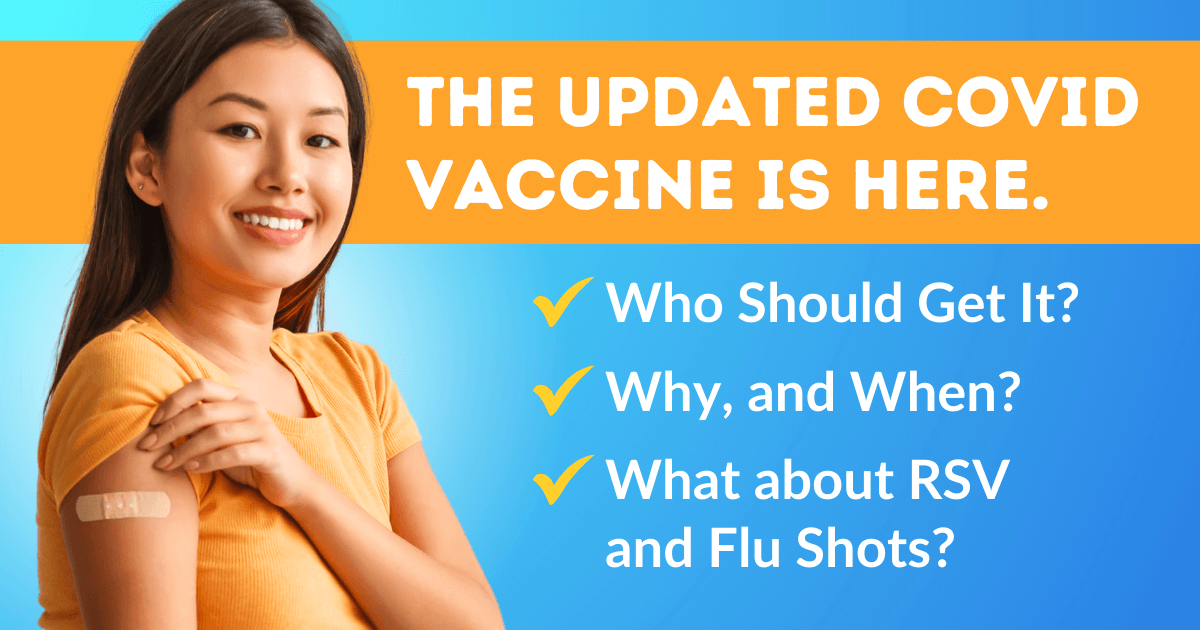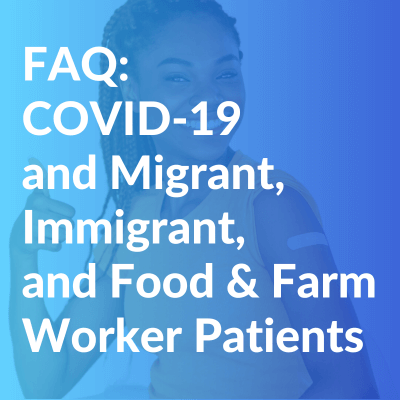The Updated COVID Vaccine Is Here. Who Should Get It, Why, and When? What about RSV and Flu Shots? Your Questions Answered.

The updated vaccine is shipping to health centers, health departments, and retail pharmacies across the US after its approval last week by the FDA and release of recommendations by the CDC. While we continue to update our long-form COVID FAQ with lots of new information and data, we also wanted to answer your top questions as soon as possible. Watch for a fully updated FAQ in the coming weeks. In the meantime, here are some of the top questions we’ve received from clinicians serving underserved groups like migrants, immigrants, asylum seekers, and food and farmworkers.
Who should get the updated COVID vaccine?
Anyone ages six months and older should get the updated COVID vaccine to increase their protection for the upcoming respiratory illness season. The health disparities that drove up COVID infections among many migrant, immigrant, and farmworker communities are still bearing down on these communities, from poverty and food insecurity, to poor protection at the workplace, to higher rates of diabetes. Additionally, migrant, immigrant, and farmworker patients may encounter increased barriers to accessing the vaccine, including fear of exposing documentation status, lack of transportation, lack of educational materials or outreach in the language of their choice, lack of childcare, concern after hearing misinformation, etc.
While the federal government has covered the cost of the vaccine for uninsured people through 2024, the funding for outreach and education has ceased. It is critical that clinics, health departments, and other vaccine provision locations continue to connect with the historically marginalized and isolated members of their communities to facilitate vaccine access, with health fairs, mobile clinics, and partnerships with churches, farmers’ markets, and other local community groups.
Why should a patient get the updated COVID vaccine?
Anyone ages six months and older should get the updated COVID vaccine to increase their protection for the upcoming respiratory illness season. Encourage your patients to get vaccinated, and remind them that it is safe and effective. Here are the top six reasons for a patient to get an updated COVID vaccine this fall:
- Get prepared for increased exposures: COVID cases and hospitalizations are increasing, and are expected to spike as we enter the fall and winter. The patient likely does not have much protection from previous vaccines. In the last year, only 17% of the population chose to get the (now unavailable) COVID bivalent booster that was first released last fall, meaning the vast majority of the US population – even those who received vaccines earlier in the pandemic – have not had a vaccine for a year or longer, and their antibodies have decreased.
- Avoid the emergency room: If you do contract COVID, you will likely have a shorter-duration illness, which reduces the window during which you are very sick and can spread the disease. That 17% of the population who got the vaccine saw 60% effectiveness against urgent care and emergency department visits and 65% effectiveness against hospitalization – a remarkable reduction in severe disease!
- Get evidence-backed protection: The patient has unknown protection from previous infections. The only way to be certain to increase antibodies is to get vaccinated. To visualize the risk, a patient can use the COVID-19 Immunity Estimator.
- Reduce risk of long COVID: People with less severe illness are at a lower risk of long COVID.
- Reduce the duration of transmission: Vaccination shortens illness, which in turn shortens the time during which the patient is infectious. This can be the difference between holidays with the abuelos, or staying home sick.
- Get safe and effective coverage! Remind patients that, contrary to the misinformation that is prevalent in social media, this vaccine has very few side effects. Additionally, it is expected to be very effective at increasing antibodies against the COVID subvariants in circulation right now, including BA.2.86.
Access the vaccine for free, for now: Private insurance is covering the vaccine. For those without insurance, the vaccine is available for free with government funding, available at community health centers, health departments, and pharmacies, at least through 2024.
Can a migrant patient get the COVID updated vaccine and the influenza vaccination at the same time?
Yes. Multiple studies, including a September 2023 study in JAMA Network Open, have found it is safe to get the COVID updated vaccine and the flu shot at the same time. Migrant patients who have limited access to health services may have very few opportunities to get vaccinated and it is recommended that they get both as soon as they can.
Can a patient get the flu vaccine, the updated COVID vaccine, and the new RSV vaccine at the same time?
The RSV vaccine, new for fall 2023, is now available for patients over 60 who consult with their doctor. As of mid-September 2023, the CDC has not yet offered guidance regarding the spacing of the RSV vaccine relating to COVID and flu shots. Patients should talk to their doctor about timing, considering previous vaccines and infections and personal risk factors.
What are the pros and cons of splitting the COVID and flu (and RSV) vaccines?
Many of our patients have poor access to vaccines, due to work inflexibility and schedules, transportation, child care, and more. The primary benefit of giving the COVID and flu shot simultaneously is that the patient, including children, will not need to arrange to return to the clinic for a second shot (or a third time, if they are eligible for the RSV vaccine). This is a very serious concern, because no vaccination means no protection.
If their work schedules are more flexible and access to services is good, they may wish to split the vaccines up. Some have recently had a COVID infection and may delay the vaccine for three months after infection. Some people prefer to get the vaccines on different days, as both shots on the same day may increase side effects like headache, fatigue, fever, and pain at the injection site. Others may wish to time the COVID vaccine to have peak effectiveness over certain events or the holidays, or to time the vaccines to provide highest coverage during the historical peaks of the virus. (The historic peak of the flu, for example, is in February; RSV typically peaks in December but peaked in November last year; COVID has had multiple peaks throughout the year, but its deadliest months of each year have been January.) Additionally, studies show that coadministration of the COVID and flu shots very minimally decreases effectiveness. However, clinicians should be careful to ensure that delaying the vaccine will not result in barriers that lead to no vaccine.
What do we know about the fall 2023 vaccine?
Some key aspects of the updated COVID vaccine that is now available at health centers, health departments, and retail pharmacies:
- Effective: This revised vaccine targets the XBB.1.5 subvariant of the Omicron strain of COVID. This vaccine is expected to be effective against all of the major subvariants in circulation, including EG.5, FL.1.5.1, and XBB.1.16. Emerging data show it is also effective against BA.2.86, which is very different from XBB.
- Cost and availability: The vaccine is now available. Patients can see exactly what locations have received the updated vaccines online on https://www.vaccines.gov/search/. Those without insurance are eligible for a free vaccine paid by the federal government. Those with private insurance will be covered by their insurance.
- Language change: This vaccine is not a bivalent vaccine, as it does not target two strains of COVID, but just one – the XBB subvariants of Omicron. It also now acts as the initial dose for those who have never been vaccinated for COVID, not just as a booster. This means, going forward, the language will change – this vaccine will be called “the updated COVID vaccine” or “the COVID vaccine” instead of a “booster” or a “bivalent vaccine.”
- Looking ahead, a simpler process: COVID vaccines are likely to shift to be more like the flu vaccine – one shot available in the fall, updated to best match the variants expected to dominate over the winter. Most people (the exceptions being children under six and immunocompromised people) will have just one shot to get, regardless of whether they have had an initial series or not, and the language and messaging can be simplified to reduce confusion.
What do we know about the latest subvariants that are spreading?
In early September 2023, the Omicron subvariant, EG.5.1, also called Eris, comprised over 20% of COVID cases tested in the US. FL.1.5.1 was responsible for 14.5%. XBB.1.16 and XBB.1.16.6 accounted jointly for about 18% of cases, with XBB.2.3 estimated at 8.1%, according to the CDC. All five variants appear to be very similar in terms of transmissibility, symptoms, and severity. Another, but very different, Omicron subvariant called BA.2.86 is also in the news, but has had low detection levels thus far. The new updated COVID vaccine is effective against all of these variants, including BA.2.86.
Some other things we know:
- EG.5.1
- EG.5.1 may have “more immune escape” compared to the XBB variants, meaning it may be even more transmissible than the other strains.
- EG.5.1 may have “more immune escape” compared to the XBB variants, meaning it may be even more transmissible than the other strains.
- XBB subvariants
- XBB.1.16 has been reported to be linked to conjunctivitis in children, but the condition, known colloquially as “pink eye,” has been reported with other strains as well.
- Both XBB.1.16 and XBB.1.5 are themselves highly transmissible – the most transmissible of any previous COVID variants. XBB.1.5 has been estimated at 20% more transmissible than the already-highly-transmissible BQ.1, and XBB.1.16 is likely more transmissible than XBB.1.5.
- Across these Omicron subvariants
- There is an uptick in hospitalizations for COVID, but this may be at least in part a result of changes in human behavior related to extreme heat, summer travel, and the return to school, rather than to the severity of these subvariants.
- Symptoms are the same as earlier variants, including shortness of breath, fever, sore throat, muscle aches, and cough. The loss of smell is, however, less prevalent compared to the first variants.
- Early data suggest that infections are similar in severity compared to recent other Omicron subvariants.
- The updated vaccine is “better aligned” against these variants than the previous bivalent booster, as the updated vaccine was created against XBB. It is even expected to be effective against BA.2.86, according to Moderna.
- BA.2.86
- Currently nicknamed "Pirola," this subvariant is related to Omicron subvariant BA.2, which circulated in 2022.
- Very few cases of this new variant have been detected, so very limited information is available. It has yet to be named a variant of concern by the World Health Organization, but it has begun to be monitored by the WHO.
- This subvariant has 35 mutations on the spike protein, meaning this subvariant is significantly different than what is currently circulating.
- The cases that have been detected were spread out but with similar genetic sequences, indicating a possibility of rapid spread.
- More data are needed, but with less funding and less testing of genotypes, our information of its spread is likely to be less robust.
- The updated vaccine is expected to be effective against this subvariant.
- Log in to post comments





